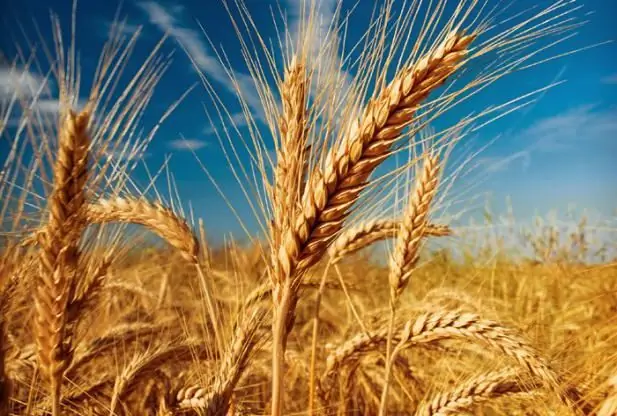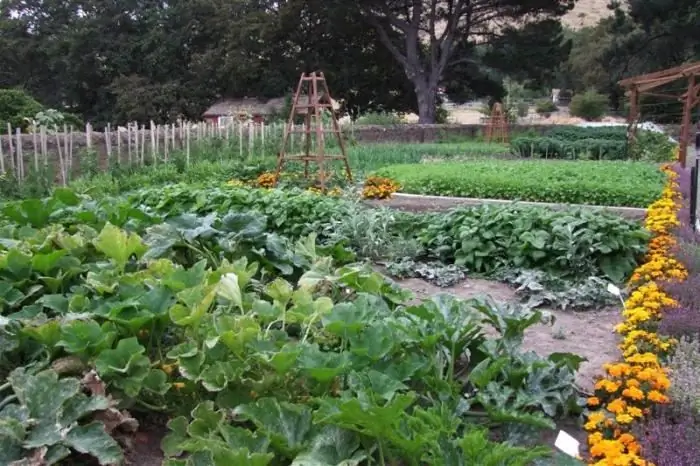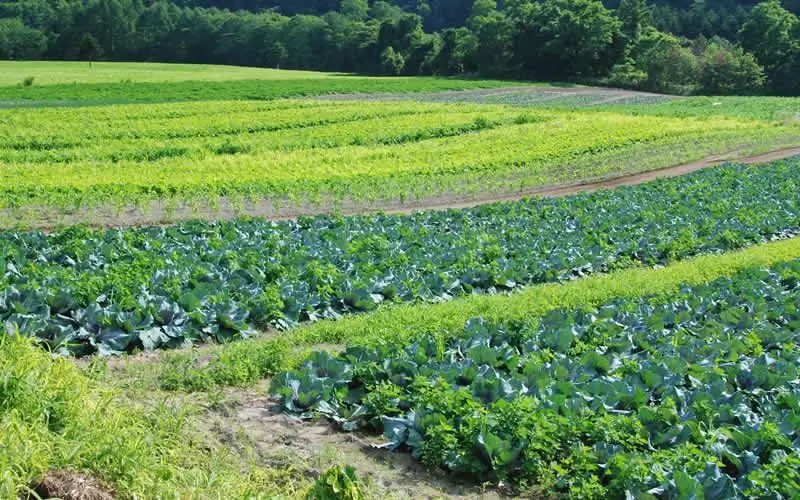2026 Author: Howard Calhoun | [email protected]. Last modified: 2025-06-01 07:12:56
To get a bountiful harvest and protect the land from diseases and pests, it is important to know the basic rules of soil management, including what is crop rotation in the field and in garden beds.
The soil needs to rest. Just as a person needs rest after hard monotonous work, so the land on which the same crop is grown year after year is physically exhausted and tired. The best rest for a person is a change of activity. The best rest for the soil is a change of crops.

Crop rotation as a method of farming
Crop rotation is the systematic rotation of annual crops. This technique allows you to avoid depletion of the soil and from year to year to get a rich harvest on the same beds, without leaving them empty for rest.
Rotation must be carefully planned so that the preceding plants help to grow a rich harvest of those crops that will be planted next year. This way of farming is part of organic farming, natural, close to nature.
Why do you needcrop rotation?
For the proper organization of planned crop rotation, it is important to understand not only what crop rotation is, but also what it is for.
Thanks to the rotation of annual vegetable and berry plants, it is possible to maintain the optimal ratio of nutrients and microelements in the soil. For successful development, different cultures need their own natural elements inherent in them:
- nitrogen - for leaf species;
- phosphorus - for root crops;
- potassium - for fruit plants.
If you plant the same type of crop every year, there is a shortage of the element that was most in demand. The planned rotation of plant groups helps to avoid this. Thanks to the alternation, it is possible to maintain a balance of nutrients: soil properties are used systematically, the deficiency of elements is replenished by subsequent crops.
In addition, botanically related plants growing nearby can be affected by the same pests or diseases. Insect larvae, pathogens accumulate in the soil and in the new season are capable of destroying the entire plantation of crops in a short time. Timely relocation of plants to a new place deprives pests of the opportunity to damage future plantings.
There is an additional plus of crop rotation and the accompanying grouping of garden crops in accordance with their needs - this principle of planting facilitates the work of a gardener-gardener, since the same conditions for watering, mulching, and lighting are created within the same planting area.

Crop rotation system
Different principles, schemes, systems of crop rotation have been formed over the centuries, like a test of weather conditions, soil composition, pest invasion. The general principle of rotation is that the same plants cannot grow in the same place twice in a row.
A more complex crop rotation system includes plant rotation schemes in one place for a period of 3, 5 and 10 years. The minimum period is 3 years. The most common are 2 traditional planting rotation patterns:
- within families;
- within groups: leafy, berry crops, root crops.
For alternation it is convenient to use green manure, that is, plants grown as green manure. If green manure is included in the crop rotation system, then the following planting principle should be followed:
- before foliar crops - legumes;
- before root crops - sowing rye, which will loosen the soil, make it water and breathable.
In addition to botanical proximity, it is also necessary to take into account how plants from the same family or group are sympathetic or, on the contrary, unfriendly to the neighborhood of their "relatives".
Types of crop rotations
What is crop rotation? The concept also includes an idea of the types of alternation associated with the practical purpose of crops:
- field - at least ½ of the entire cultivated area is given for grain, industrial, vegetable crops, including potatoes;
- fodder - the predominant volume of the area is occupied by fodder crops. These are vegetables (including sugar beets), cereals, herbs for fodder;
- special - 1-2 types of crops are grown on ½ of the plowed area - gourds, rice, certain groups of vegetables.
Field rotation
Agricultural complexes and large farms are sure to follow this type of crop rotation, which allows not only to protect the soil, but also to enrich it thanks to multi-year plans for planting crops in large areas.
Large farms typically have 5 to 10 fields used in a crop rotation.
In a system of ten crop rotations, early potatoes with winter crops, potatoes with barley, winter crops with clover, flax with winter and spring grains can alternate.
Another version of the 10-field crop rotation involves alternating legumes with winter crops, potatoes with legumes and corn, spring and grains with grasses, and then with flax, winter crops with spring cereals.
There are a variety of options for field crop rotation. The most efficient type of crop rotation for each specific farm is selected on the basis of comparative estimates, which are made taking into account the yield of field products from each hectare of land used.

Crop rotation in livestock farms
Farms specializing in livestock products practice forage crop rotation, whichdivided into 2 varieties:
- Grassland - grasses are grown for hay or grazing, which can be annuals or perennials. This type of crop rotation prevails in compactly located farms with lands with similar fertility.
- Pri-farmsky - grasses, silage crops or root crops for fodder purposes are grown in the fields near farms.
Feed products are difficult to transport due to large volumes. For crops, a large amount of organic matter (manure) is needed. Therefore, the near-farm type of crop rotation is practiced in cases where the farm is large, and the lands located nearby allow the land to be occupied by fodder crops.

Examples
Depending on climatic conditions, examples of crop rotations may be different. Here is one option:
- 1 year - corn for silage or grass (annual);
- from 2 to 4 years - alfalfa (especially on forest gray lands);
- 5 and 6 years - grain corn;
- 7 year - herbs (annual);
- 8 year - fodder roots;
- 9 year - gourds (for fodder).
In the Non-Black Earth region, the rotation of crops may be different:
- 1 year - annual grasses that are harvested early for silage + overseeding of perennials;
- 2-3 years - perennial herbs;
- Year 4 - silage crops;
- 5 year - spring cereals + ryegrass overseeding;
- 6 year - root crops intended for livestock feed.
For near-farmcrop rotations in the Non-Black Earth region use grass, rutabaga and fodder beets, turnips, in the southern and central zone - silage corn, beets for fodder. Silage mixtures are sunflower, oats, peas, corn, rapeseed. Rutabaga, fodder and sugar beet, turnip rutabaga are planted as fodder root crops.

What fertilizers are used
An important component in the crop rotation is fertilizer. Lettuce, cabbage, and other leafy crops require a high nitrogen content, fruit crops need potassium, root crops prefer phosphorus, spring barley needs an acidic soil reaction, spring crops need a complete mineral fertilizer.
Saturation of gray forest soils with nitrogen guarantees high yield increases.
Adhering to crop rotation, apply a system of organic and mineral fertilizers, considering:
- planned yield size;
- soil properties - type, composition, reaction, amount of nutrients;
- agricultural technology and work deadlines;
- balance of mineral and organic fertilizers,
- fertilizer application methods;
- type of crop rotation;
- what was the previous culture.
It is important not only the schedule of fertilizer application in the current year for cultivated crops, but also the systematic improvement of the soil to increase yields next year, maintaining soil fertility.
So, for example, clover responds best to organic fertilizers that were applied under the crop that preceded it. Herb nutritionit is more effective to carry out in early spring or after mowing.

Tillage
When crop rotations are used, tillage is an important part of the farming technique associated with resting the soil under fallow. There are such types of crop rotations:
- grain fallow - common in drought-prone areas;
- grain-rowed - ½ part of grains alternate with row crops and fallow, the land is not left fallow;
- grain-grass - cereals and perennial grasses are sown in strips without leaving land fallow;
- row crop - used on lands with artificial irrigation or in humid climate zones;
- grass-rowed - used on soils that are artificially irrigated or located in floodplains;
- green manure - distributed on sandy soils.
Crop rotation varieties are taken into account when tilling the soil, which can be shallow (up to 8 cm) or shallow (10-12 cm) if carried out after late predecessors, or deep - when plowing a month before sowing subsequent crops.

Crop rotation in the garden
For gardeners it is also important to understand what crop rotation is. The systematic use of a personal plot allows saving several acres of land from depletion, increasing the yield of monocultures.
Natural balance is fully restored by alternating plants at least once every 3-4 years. This requires allthe plot is divided into 3 zones:
- a place to grow nutrient-demanding plants. These are spinach, zucchini, potatoes, cabbage, pumpkin;
- plot for crops less demanding on soil fertility - cucumber, beets, tomatoes, melons, eggplants;
- a place for planting unpretentious soil fertility crops - onions, green peas, beans, spicy aromatic perennial herbs.
After a year, the plants of each group replace each other. At the same time, mineral fertilizers are applied to the soil for root crops, organic fertilizers for cabbage, zucchini, pumpkin.
If you translate the crop rotation scheme into a simplified version, then you need to annually change the "tops" (tomatoes, cucumbers, cabbage) and "roots" (carrots, beets) in the beds.
Onions and garlic are being replaced by any crops. Potatoes and tomatoes are replaced by cabbage, cucumbers, pumpkin, beans, peas, dill. Replacement for squash cucumbers, zucchini - radishes, cabbage, beets, peas, potatoes.
With this simple scheme, you can not only maintain the natural balance of trace elements, but also increase yields.
Recommended:
Crop production - what kind of activity is this? Branches and areas of crop production

More than two-thirds of the products consumed by the population of the planet are provided by the leading branch of agriculture - crop production. This is the fundamental basis of world agricultural production. Consider its structure and talk about the achievements and development prospects of this world economy
Crop rotation in the garden. What then can be planted in the garden

Growing vegetables and herbs in your garden for many today is both a useful and a favorite pastime. Of course, it is very important to get a good harvest from your site. The best result is achieved when the crop rotation in the garden is properly adjusted
Crop rotation of vegetable crops is the basis for increasing their yield

For a long time, many farmers could not understand the reasons why the yield of an agricultural crop decreases when it is grown in the same place for several years. The first harvest, even under unfavorable conditions, always turned out to be larger than the subsequent ones, although the agricultural technique of cultivation remained at the same level, and often even improved - organic fertilizers were applied, the soil became more fertile
Rotation: what is it and why is it needed

Rotation - what is it? In essence, this term means the movement from one place to another of elements within the same group. An example is the rotation of personnel within an organization, that is, the transfer of employees from one position to another
Crop rotation at their summer cottage: basic rules

To avoid low fruiting of vegetables, many experienced farmers resort to such a method in summer cottages as crop rotation. The successful implementation of this principle requires a thoughtful approach and organization, which involves the development of some methods of planting plants and drawing up a plan. Information about this will be discussed in our article

